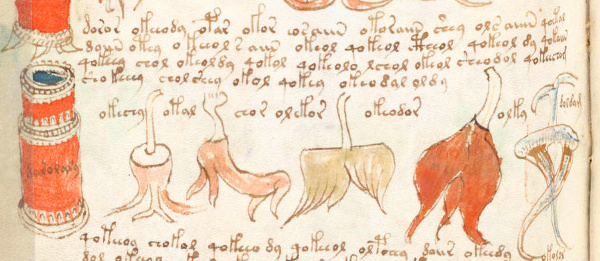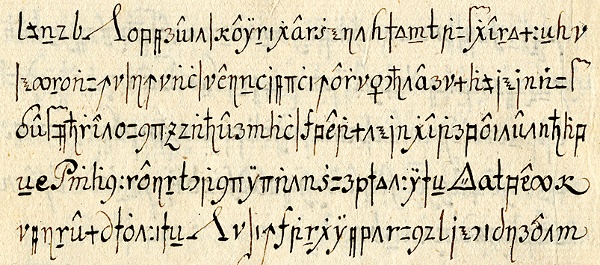Secret Writing
November 4, 2011

These strange symbols[1] can be found in a fifteenth century
manuscript that remains a mystery to this day. This 240 page manuscript, called the
Voynich manuscript after one of its owners, now resides at the
Beinecke Rare Book and Manuscript Library of
Yale University, listed as
Beinecke MS 408.[2] The manuscript has its own web site at
http://www.voynich.nu, and it's been an object of study by amateur and professional
cryptographers for many years.
It's unlikely that the manuscript is a
hoax, since the "letters" it is written in follow the
statistical rules of a language. In particular,
Zipf's Law of word frequency is obeyed. What adds to the mystery are the many hand-drawn illustrations, mostly of
botanical objects, that accompany the text (see figure).

A portion of page 176 of the Voynich Manuscript. (Via Wikimedia Commons).
The dating of the manuscript has been certain since 2009, when a team of
physicists from the
University of Arizona used an
accelerator mass spectrometer in a
radiocarbon dating of the book
vellum. Their experimentally determined date was in the range 1404 to 1438, or the early Renaissance.[3] It wasn't possible to date the
inks by radiocarbon techniques, since they're
inorganic, but other studies have indicated that the ink was applied to fresh vellum.
The Voynich Manuscript is not the only manuscript rendered in a secret code. Another, more recent manuscript is the
Copiale Cipher, a 105 page volume of about 75,000 characters, dated to about 1760-1780.[4] The writing is rendered in 90 different characters that include
Roman and
Greek letters and
abstract symbols (see figure).

A portion of page 76 of the Copiale Cipher. (Via The Copiale Cipher Web Site by Kevin Knight, Beáta Megyesi and Christiane Schaefer).
Although no one has been able to decipher the Voynich Manuscript, a decoding of the Copiale Cipher has just been done by
Kevin Knight of the
University of Southern California Information Sciences Institute; and
Beáta Megyesi and Christiane Schaefer of the
Department of Linguistics and Philology,
Uppsala University. Their Copiale Cipher work was presented at this year's meeting of The
Association for Computational Linguistics.[5]
The decoded text is a book of
rituals, in
German, that's related to a later, eighteenth century secret society called the "oculist order".[4] Strangely, for a society whose members were not
eye doctors, the book contains much about
eye surgery and
ophthalmology.[5] I'm reminded of the
Peter Sellers movie, "
Being There," in which Sellers plays a simpleton gardener who rambles on about gardening, while everyone interprets what he says as a profound
allegory.[6]
After attempts at
decipherment into eighty languages by common
cryptanalysis methods, the research team had the insight that the Roman characters were placed in the document solely for the purposes of
obfuscation. The message was written in the abstract symbols and Greek letters, alone.[5]
Stargate fans will be pleased to note that one of the symbols is the
Earth Alpha Gate, "point of origin," symbol.
Mapping abstract symbols with similar shapes to letters, or groups of letters, in other languages resulted in readable German text.[5] In the end, the text renders as prescriptions for various rituals, such as the following fragment.
"On this table there is bible, on both sides of the table there are four wax candles in form of a square, a battle sword, a container with oil with all kinds of herbs, a bowl with well water."
Kevin Knight and Sujith Ravi, a freshly minted USC computer science Ph.D., have been tackling language translation as a cryptographic problem, an unusual approach that seems to have many benefits.[5] There's a short YouTube video about decoding the Copiale Cipher.[7] The
National Science Foundation has funded Knight's research.
References:
- TrueType Voynich Manuscript Font, donated to the Public Domain by Glen Claston, 2005, is available as Voynich.ttf
- Beinecke Rare Book and Manuscript Library, Yale University.
- Daniel Stolte, "UA Experts Determine Age of Book 'Nobody Can Read'," University of Arizona News, February 9, 2011.
- Kevin Knight, Beáta Megyesi and Christiane Schaefer, "The Copiale Cipher."
- Suzanne Wu, "USC Scientist Cracks Mysterious Copiale Cipher," University of Southern California News, October 25, 2011.
- Being There (1979, Hal Ashby, Director) on the Internet Movie Database.
- USC Scientist Cracks Mysterious "Copiale Cipher", YouTube Video.
Permanent Link to this article
Linked Keywords: Manuscript; Voynich manuscript; Beinecke Rare Book and Manuscript Library; Yale University; http://www.voynich.nu; cryptographers; hoax; frequency analysis; statistical rules of a language; Zipf's Law; botanical; Wikimedia Commons; physicist; University of Arizona; accelerator mass spectrometer; radiocarbon dating; vellum; ink; inorganic; Copiale Cipher; Latin alphabet; Roman characters; Greek letters; abstract symbols; Kevin Knight; University of Southern California; Information Sciences Institute; Beáta Megyesi; Department of Linguistics and Philology; Uppsala University; Association for Computational Linguistics; ritual; German; eye doctor; eye surgery; ophthalmology; Peter Sellers; Being There; allegory; decipherment; cryptanalysis; obfuscation; Stargate; National Science Foundation.